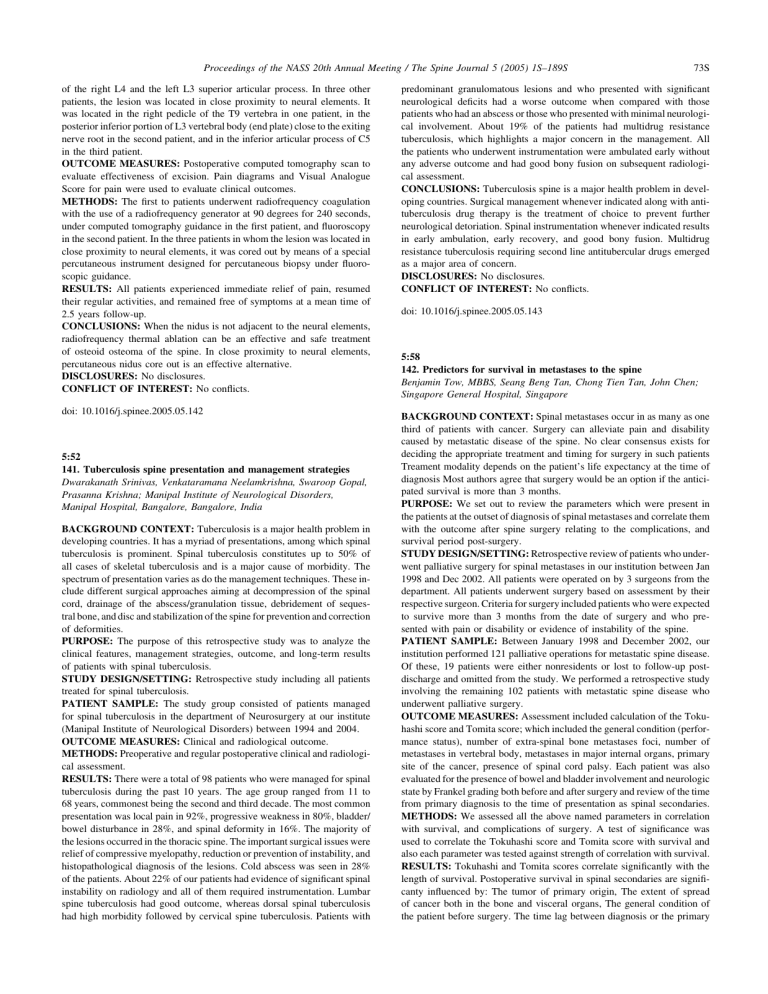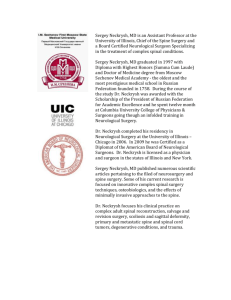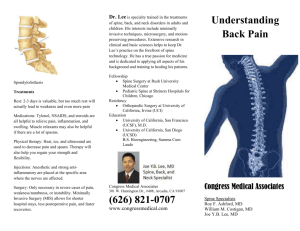
Proceedings of the NASS 20th Annual Meeting / The Spine Journal 5 (2005) 1S–189S of the right L4 and the left L3 superior articular process. In three other patients, the lesion was located in close proximity to neural elements. It was located in the right pedicle of the T9 vertebra in one patient, in the posterior inferior portion of L3 vertebral body (end plate) close to the exiting nerve root in the second patient, and in the inferior articular process of C5 in the third patient. OUTCOME MEASURES: Postoperative computed tomography scan to evaluate effectiveness of excision. Pain diagrams and Visual Analogue Score for pain were used to evaluate clinical outcomes. METHODS: The first to patients underwent radiofrequency coagulation with the use of a radiofrequency generator at 90 degrees for 240 seconds, under computed tomography guidance in the first patient, and fluoroscopy in the second patient. In the three patients in whom the lesion was located in close proximity to neural elements, it was cored out by means of a special percutaneous instrument designed for percutaneous biopsy under fluoroscopic guidance. RESULTS: All patients experienced immediate relief of pain, resumed their regular activities, and remained free of symptoms at a mean time of 2.5 years follow-up. CONCLUSIONS: When the nidus is not adjacent to the neural elements, radiofrequency thermal ablation can be an effective and safe treatment of osteoid osteoma of the spine. In close proximity to neural elements, percutaneous nidus core out is an effective alternative. DISCLOSURES: No disclosures. CONFLICT OF INTEREST: No conflicts. doi: 10.1016/j.spinee.2005.05.142 5:52 141. Tuberculosis spine presentation and management strategies Dwarakanath Srinivas, Venkataramana Neelamkrishna, Swaroop Gopal, Prasanna Krishna; Manipal Institute of Neurological Disorders, Manipal Hospital, Bangalore, Bangalore, India BACKGROUND CONTEXT: Tuberculosis is a major health problem in developing countries. It has a myriad of presentations, among which spinal tuberculosis is prominent. Spinal tuberculosis constitutes up to 50% of all cases of skeletal tuberculosis and is a major cause of morbidity. The spectrum of presentation varies as do the management techniques. These include different surgical approaches aiming at decompression of the spinal cord, drainage of the abscess/granulation tissue, debridement of sequestral bone, and disc and stabilization of the spine for prevention and correction of deformities. PURPOSE: The purpose of this retrospective study was to analyze the clinical features, management strategies, outcome, and long-term results of patients with spinal tuberculosis. STUDY DESIGN/SETTING: Retrospective study including all patients treated for spinal tuberculosis. PATIENT SAMPLE: The study group consisted of patients managed for spinal tuberculosis in the department of Neurosurgery at our institute (Manipal Institute of Neurological Disorders) between 1994 and 2004. OUTCOME MEASURES: Clinical and radiological outcome. METHODS: Preoperative and regular postoperative clinical and radiological assessment. RESULTS: There were a total of 98 patients who were managed for spinal tuberculosis during the past 10 years. The age group ranged from 11 to 68 years, commonest being the second and third decade. The most common presentation was local pain in 92%, progressive weakness in 80%, bladder/ bowel disturbance in 28%, and spinal deformity in 16%. The majority of the lesions occurred in the thoracic spine. The important surgical issues were relief of compressive myelopathy, reduction or prevention of instability, and histopathological diagnosis of the lesions. Cold abscess was seen in 28% of the patients. About 22% of our patients had evidence of significant spinal instability on radiology and all of them required instrumentation. Lumbar spine tuberculosis had good outcome, whereas dorsal spinal tuberculosis had high morbidity followed by cervical spine tuberculosis. Patients with 73S predominant granulomatous lesions and who presented with significant neurological deficits had a worse outcome when compared with those patients who had an abscess or those who presented with minimal neurological involvement. About 19% of the patients had multidrug resistance tuberculosis, which highlights a major concern in the management. All the patients who underwent instrumentation were ambulated early without any adverse outcome and had good bony fusion on subsequent radiological assessment. CONCLUSIONS: Tuberculosis spine is a major health problem in developing countries. Surgical management whenever indicated along with antituberculosis drug therapy is the treatment of choice to prevent further neurological detoriation. Spinal instrumentation whenever indicated results in early ambulation, early recovery, and good bony fusion. Multidrug resistance tuberculosis requiring second line antitubercular drugs emerged as a major area of concern. DISCLOSURES: No disclosures. CONFLICT OF INTEREST: No conflicts. doi: 10.1016/j.spinee.2005.05.143 5:58 142. Predictors for survival in metastases to the spine Benjamin Tow, MBBS, Seang Beng Tan, Chong Tien Tan, John Chen; Singapore General Hospital, Singapore BACKGROUND CONTEXT: Spinal metastases occur in as many as one third of patients with cancer. Surgery can alleviate pain and disability caused by metastatic disease of the spine. No clear consensus exists for deciding the appropriate treatment and timing for surgery in such patients Treament modality depends on the patient’s life expectancy at the time of diagnosis Most authors agree that surgery would be an option if the anticipated survival is more than 3 months. PURPOSE: We set out to review the parameters which were present in the patients at the outset of diagnosis of spinal metastases and correlate them with the outcome after spine surgery relating to the complications, and survival period post-surgery. STUDY DESIGN/SETTING: Retrospective review of patients who underwent palliative surgery for spinal metastases in our institution between Jan 1998 and Dec 2002. All patients were operated on by 3 surgeons from the department. All patients underwent surgery based on assessment by their respective surgeon. Criteria for surgery included patients who were expected to survive more than 3 months from the date of surgery and who presented with pain or disability or evidence of instability of the spine. PATIENT SAMPLE: Between January 1998 and December 2002, our institution performed 121 palliative operations for metastatic spine disease. Of these, 19 patients were either nonresidents or lost to follow-up postdischarge and omitted from the study. We performed a retrospective study involving the remaining 102 patients with metastatic spine disease who underwent palliative surgery. OUTCOME MEASURES: Assessment included calculation of the Tokuhashi score and Tomita score; which included the general condition (performance status), number of extra-spinal bone metastases foci, number of metastases in vertebral body, metastases in major internal organs, primary site of the cancer, presence of spinal cord palsy. Each patient was also evaluated for the presence of bowel and bladder involvement and neurologic state by Frankel grading both before and after surgery and review of the time from primary diagnosis to the time of presentation as spinal secondaries. METHODS: We assessed all the above named parameters in correlation with survival, and complications of surgery. A test of significance was used to correlate the Tokuhashi score and Tomita score with survival and also each parameter was tested against strength of correlation with survival. RESULTS: Tokuhashi and Tomita scores correlate significantly with the length of survival. Postoperative survival in spinal secondaries are significanty influenced by: The tumor of primary origin, The extent of spread of cancer both in the bone and visceral organs, The general condition of the patient before surgery. The time lag between diagnosis or the primary



